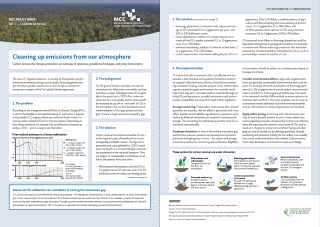Cleaning up emissions from our atmosphere
The issue of "negative emissions" is moving up the agenda, and governments are already setting concrete goals. Reducing greenhouse gas emissions quickly towards zero is not enough to achieve the temperature targets of the Paris global climate agreement.
1. The problem
According to the Intergovernmental Panel on Climate Change (IPCC), it will not be feasible to limit global heating to well below 2 degrees and possibly to 1.5 degrees above pre-industrial levels without removing carbon dioxide (CO2) from the atmosphere. Depending on how slowly emissions are reduced, this could become necessary as early as 2030 – and on a large scale thereafter.
2. The background
For the goal of climate neutrality, we need to compensate for effectively unavoidable residual emissions: at least 100 gigatonnes of CO2 globally in the period up to 2100. Also, unless we reach net zero very quickly, carbon removal will be necessary to pay off an "overdraft" of CO2 in the atmosphere. But we lack development and implementation of the appropriate technologies; there is a huge innovation and policy gap.
3. The solution
Carbon removal must become feasible in time – at the required scale, efficiently and in a socio-ecologically justifiable manner. The figures for potentials and costs (globally for 2050 in each case) are based on a correspondingly conservative assessment of the research literature. They are subject to considerable uncertainties; in addition, the options limit each other:
- Afforestation/reforestation: potential 0.5 to 3.6 gigatonnes of CO2 per year, costs 0 to 50 dollars per tonne in today's purchasing power;
- bioenergy plantations: combustion with capture and storage of CO2, potential 0.5 to 5 gigatonnes per year, costs 100 to 200 dollars per tonne;
- ocean alkalinisation: addition of crushed minerals to increase pH and CO2 uptake, potential 0.1 to 10 gigatonnes per year, costs 14 to 500 dollars per tonne;
- enhanced weathering: addition of minerals to land areas, 2 to 4 gigatonnes per year, 50 to 200 dollars per tonne;
- carbon sequestration in farmland: adding biochar, 0.5 to 2 gigatonnes, 30 to 120 dollars; modified patterns of agriculture with less ploughing and more planting of ground covers, 2 to 5 gigatonnes per year, 0 to 100 dollars per tonne; and
- air filter systems: direct capture of CO2 using chemical processes, 0.5 to 5 gigatonnes per year, 100 to 300 dollars per tonne.
CO2 extracted via air filters or bioenergy plantations could be deposited underground in geological formations: for example, in onshore and offshore natural gas reservoirs that have been pumped dry. It is also possible to mineralise the CO2, i.e. to fix it permanently in certain formations of rock.
4. The implementation
To ensure that carbon removal is safe, cost-effective and sustainable, a new incentive and regulatory framework needs to be created. In the short term, the focus should be on monitoring, innovation funding, and pilot projects. In the medium term, separate quantity targets and incentives for removals would help. In the long term, removals could be rewarded through existing CO2 pricing systems, provided permanence and environmental compatibility are ensured through further regulation.
Arrange monitoring. Policymakers must ensure that removal quantities are accurate, that the effect is permanent and is not offset. Quality control, liability regulations for operators, and a backup by financial institutions are needed for underground storage. The accounting for withdrawal quantities must be coordinated internationally.
Accelerate innovation. In view of the striking innovation gap and the time pressure, research and development should be promoted through grants or loans – for capture and storage processes as well as for monitoring and verification. Eligibility of new options should be subject to a review process based on transparent criteria.
Consider environmental effects. Large scale negative emissions can generate considerable environmental and social impacts. For example, the land consumption of bioenergy plantations for 10s of gigatonnes of annual carbon removal would cause a problem for food supply and biodiversity. This needs to be examined carefully. Differentiated incentive systems can minimise such conflicts in the ramp-up phase, and in some circumstances reward additional local environmental benefits, such as reforestation or carbon sequestration on farmland.
Apply carbon pricing. In the long term, the economic principle of environmental taxation to price in externalities also works regarding removals: climate policy is most cost-effective when the state pays the same for every tonne of CO2, and as much as it charges for every tonne emitted. Paying and charging can also be carried out by defining quantities, through auctioning and emissions trading. As the carbon price steadily rises, more costly removal becomes realistic. Early announcement helps developers and investors to plan accordingly.






